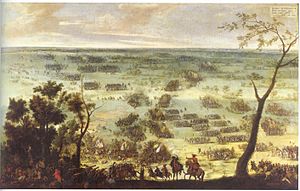Battle of Stadtlohn facts for kids
Quick facts for kids Battle of Stadtlohn |
|||||||
|---|---|---|---|---|---|---|---|
| Part of the Palatinate phase of the Thirty Years' War | |||||||
 Battle of Stadtlohn, oil painting by Peter Snayers |
|||||||
|
|||||||
| Belligerents | |||||||
| Commanders and leaders | |||||||
| Strength | |||||||
| 15,000 | 5,000+ cavalry 15,000+ infantry 14 guns |
||||||
| Casualties and losses | |||||||
| 6,000 dead 4,000 captured |
1,000 dead or wounded | ||||||
The Battle of Stadtlohn was an important fight during the Thirty Years' War. It happened on August 6, 1623, near the town of Stadtlohn in what is now Germany. This battle was between the army of the Electoral Palatinate (a Protestant area) and the army of the Catholic League.
The Catholic League's army was led by a famous general named Johann Tserclaes, Count of Tilly. The Protestant army was led by Christian of Brunswick. The Catholic side won a huge victory. This battle largely ended the fighting by the Palatinate forces. It also marked the end of the first part of the Thirty Years' War.
Contents
The Campaign Leading to Battle
A year before this battle, Christian of Brunswick had lost a fight at Fleurus. But by the summer of 1623, he had a new army of 15,000 soldiers. These soldiers were well-rested after spending winter in the Netherlands. Christian started his new plan by marching into an area called the Lower Saxon Circle.
Christian's Difficult Position
Christian's situation was not good. Other Protestant leaders did not send help. Even his friend, Ernst von Mansfeld, did not join him. This meant Christian's army was alone and could not get more soldiers.
Meanwhile, General Tilly found out where Christian was going. Tilly quickly moved his Catholic League army to stop him.
The Retreat Begins
From mid-July 1623, Christian's army had to retreat. Tilly's troops had crossed the Saxon border on July 13. Christian's army marched across the Weser River on July 27. A few days later, they crossed the Ems River. Tilly's army was better trained and kept getting closer.
On August 4, Christian left a town called Greven. Tilly was only about 30 minutes behind him. Christian's rearguard (the soldiers at the back of the army) fought hard. They held bridges over the Vechte and Dinkel rivers for two more days. This slowed Tilly down.
The Chase Continues
Tilly's army kept chasing Christian's forces. On the morning of August 6, Tilly's lead group caught Christian's rearguard. This happened near Heek. Christian's army had to fall back. They met up with another part of their army between the villages of Wessum and Wüllen.
The Battle of Stadtlohn
At 2 p.m. on August 6, Christian could not run anymore. He was forced to fight just outside the village of Stadtlohn. They fought in a ditch known as the Wüllener Landwehr. This spot was only about five miles from the Dutch border.
The Fight Begins
The Catholic soldiers thought the date was a good sign. It was the Feast of the Transfiguration, a religious holiday. Christian's army took a position on a hill. They faced a long attack with cannons.
Then, Tilly's cavalry (soldiers on horseback) attacked Christian's right side. Christian's own cavalry broke apart and ran away. When the foot soldiers saw this, they also tried to escape.
Catholic Victory
Tilly's forces quickly attacked the fleeing Protestant soldiers. About 6,000 Protestant soldiers were killed. Another 4,000 were captured as prisoners of war. Among those lost were 50 of Christian's most important officers. All of his cannons and ammunition were also captured.
Christian himself managed to escape with about 5,500 survivors. Tilly's army lost about 1,000 soldiers. Some of the captured Protestant soldiers joined Tilly's army. But most of them left later because Tilly's army had much stricter rules.
The captured cannons were shown off in the marketplace in Coesfeld. Some wounded enemy soldiers were taken to Münster for treatment. It was said that many of the fleeing soldiers who escaped the battle were hurt by angry local farmers.
What Happened Next
When Frederick V of the Palatinate heard about the huge loss, he had to make peace. He signed an agreement with Holy Roman Emperor Ferdinand II. This agreement ended the 'Palatine Phase' of the Thirty Years' War.
Frederick V lost his lands and his important position in the Electoral College. These were given to Duke Maximilian of Bavaria. Maximilian was a key leader of the Catholic League. From 1623, he became known as Maximilian I, Elector of Bavaria. His area became the Electorate of Bavaria.
However, this peace did not last long. In 1624, many countries joined together against the Holy Roman Emperor. These included England, France, the United Provinces of the Netherlands, Sweden, Denmark, Savoy, Venice, and Brandenburg. They wanted to fight against Spain and the Holy Roman Emperor.
This battle was the last major fight for Christian of Brunswick. He tried one more campaign in 1626. But he became sick and died on June 16, 1626, in Wolfenbüttel. He was only 26 years old.

